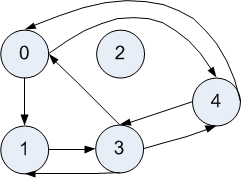Representing Graphs
Practice with Graphs
These exercises are meant to give you more practice with graphs and sets, both conceptually and in code. As such, they should help you prepare for the current assignment.
As a running example, we will use one of the directed graphs from the previous class exercises.

-
directed_graph = {0: set([1,4]), 1: set([3]), 2: set([]), 3: set([0,1,4]), 4: set([0,3])}
Of course, the previous class provided additional examples, including programs that would generate additional examples. You should also use those when testing today's programs.
Exercises
First, let's consider some graph representation issues.
-
Write a function
graph_nodes(graph)that returns a set of all the nodes in the given graph. For example,graph_nodes(directed_graph)should returnset([0, 1, 2, 3, 4]).Note that the same code should work for both directed and undirected graphs.
-
Write a function
graph_edges(graph)that returns a set of all the edges in the given directed graph. For example,graph_edges(directed_graph)should returnset([(0,1), (0,4), (1,3), (3,0), (3,1), (3,4), (4,0), (4,3)]).Note that if this function is given an undirected graph, the returned set should include each edge twice, once in each direction.
Before the next exercises, let's introduce some definitions. A directed graph node's out-degree is the number of edges pointing out of that node. A directed graph node's in-degree is the number of edges pointing into that node. For example, the out-degree of our example directed graph's node 3 is 3, and its in-degree is 2. For undirected graphs, we instead similarly define the node degree, instead of differentiating between the out- and in-degrees.
-
Write a function
outdegree(graph, node)that returns the out-degree for the given node in the given directed graph.From the previous discussion,
outdegree(directed_graph, 3)should return 3. -
Write a function
avg_outdegree(graph)that returns the average out-degree in the graph, i.e., the average of the out-degrees of all the nodes in the graph.Use the previous function, along with the function you wrote earlier in the course to compute an average.
-
Write a function
indegree(graph, node)that returns the in-degree for the given node in the given directed graph.From the previous discussion,
indegree(directed_graph, 3)should return 2. -
Write a function
avg_indegree(graph)that returns the average in-degree in the graph, i.e., the average of the in-degrees of all the nodes in the graph.Use the previous function, along with the function you wrote earlier in the course to compute an average.
-
What is the relationship between the average out- and in-degrees of the given sample directed graph? What is the relationship on other sample graphs?
They are equal to each other.
Can you argue/prove that this relationship always holds?
The average out-degree is, by definition, ( (out-degree node 0) + ... + (out-degree node n-1) ) / #nodes Let's think about that sum in the numerator. It simply totals to the number of edges in the graph. After all, every directed edge has to go out of some node, so each edge is counted somewhere in that sum. Thus, the formula simplifies to #edges / #nodes The average in-degree is, by definition, ( (in-degree node 0) + ... + (in-degree node n-1) ) / #nodes By similar reasoning, in that each directed edge has to go into some node, this also simplifies to #edges / #nodes Thus, they are the same. -
Hopefully, the thinking encouraged by the previous problem has led you to an insight about the average out- and in-degrees. (This insight is provided in the hidden solution above.) Can you now define versions of
avg_outdegree(graph)andavg_indegree(graph)that are simpler than your previous ones? -
Does the same relationship hold between the median out- and in-degrees? What about the standard deviation of the out- and in-degrees?
In short, not in general.
Next, we want to test if two sets are equal, i.e., have the same elements.
Of course, this is really easy with == or !=.
But, let's pretend that our local CodeSkulptor implementor has
accidentally broken the built-in set-equality operations.
Alas, you have witnessed that such mistakes happen.
Of course, that's just an excuse for you to think about
how you can use the remaining set operations.
-
Define the function
equal_sets1(set1, set2)that returns the appropriate Boolean. The only set operations you can use areissubset()andissuperset(). You are not allowed to convert the sets into any other data structure. -
Define the function
equal_sets2(set1, set2)that returns the appropriate Boolean. The only set operations you can use areadd(),remove(),discard(),pop(),copy(),in, andnot in. You are not allowed to convert the sets into any other data structure. Hint: You might want to define some helper function and also use the idea of the previous version.
![[Rice University]](http://www.staff.rice.edu/images/staff/branding/shield.jpg)